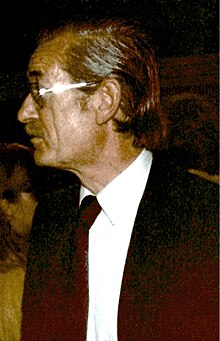Bob de Moor
| Bob de Moor | |
|---|---|
 | |
| Born | Robert Frans Marie De Moor 20 December 1925 Antwerp, Belgium |
| Died | 26 August 1992 (aged 66) Brussels, Belgium |
| Nationality | Belgian |
| Area(s) | artist, writer |
Notable works | Cori, de Scheepsjongen, The Adventures of Tintin Barelli Johan et Stephan |
| Awards | full list |
Bob de Moor is the pen name of Robert Frans Marie De Moor (20 December 1925 – 26 August 1992), a Belgian comics creator. Chiefly noted as an artist, he is considered an early master of the Ligne claire style.[1] He wrote and drew several comics series on his own, but also collaborated with Hergé on several volumes of The Adventures of Tintin. He completed the unfinished story Professor Sató's Three Formulae, Volume 2: Mortimer vs. Mortimer of the Blake and Mortimer series, after the death of the author Edgar P. Jacobs.
Biography
Bob de Moor started drawing with pencil at three or four. Living in a port town, he developed a strong interest for drawing sailing ships which carried into his professional career with his Cori, de Scheepsjongen series and other work.[2] Following studies at the Antwerp Academy of Fine Arts, De Moor started his career at the Afim animations studios.[1] His first album was written in 1944 for "De Kleine Zondagsvriend".[3]
Beginning in March 1951, starting with Destination Moon, he began a collaboration with Hergé on Tintin albums and Tintin-related material which included extensive work on sketch studies, backgrounds, layout, and ultimately animated films.
His co-worker Jacques Martin is quoted as saying that de Moor had an extraordinary facility to adapt himself to the style of others.[4] This manifested in a seamless integration with Hergé's style, as well as in him being asked on occasion to complete the work of other artists.
Bibliography
| Series | Remarks |
|---|---|
| Johan en Stefan / Johan et Stephan | 9 volumes |
| De raadselachtige meneer Barelli / L'énigmatique monsieur Barelli | 8 volumes |
| Cori, de Scheepsjongen / Cori le Moussaillon | 6 volumes |
| Professeur Troc / Monsieur Tric | 3 volumes |
| De avonturen van Nonkel Zigomar / Les aventures d'Oncle Zigomar | 6 volumes |
- 1949 Le Vaisseau Miracle
- 1949 Guerre dans le Cosmos, Ed. Coune
- 1950 Le Lion de Flandre, Ed. Deligne
- 1950 L'Enigmatic Monsieur Barelli, Ed. du Lombard
- 1950 Monsieur Tric, Ed. Bédéscope
- 1951 Les Gars des Flandres, Ed. Bédéscope
- 1951 Conrad le Hardi, Ed. Bédéscope
- 1952 Barelli à Nusa-Penida
- 1959 Les Pirates d'eau douce
- 1964 Balthazar
- 1966 Barelli et les agents secrets, Ed. du Lombard
- 1971 Le Repaire du loup, Ed. Casterman
- 1972 Barelli et le Bouddha boudant, Ed. du Lombard
- 1973 Bonne Mine à la mer (Barelli), Ed. du Lombard
- 1974 Barelli et le seigneur de Gonobutz
- 1978 Cori le Moussaillon: Les Espions de la Reine, Ed. Casterman[5]
Sources
- Footnotes
- ^ a b Lambiek Comiclopedia. "Bob de Moor".
- ^ Bourdil, Pierre-Yves and Tordeur, Bernard: "Bob de Moor. 40 ans de bande dessineée, 35 ans au côtés d'Hergé", pp. 14-5, Editions du Lombard, 1986
- ^ Coup de chapeau a Bob de Moor, Tintin magazine, 1978
- ^ Bourdil, Pierre-Yves and Tordeur, Bernard: "Bob de Moor. 40 ans de bande dessineée, 35 ans au côtés d'Hergé", pp. 91, Editions du Lombard, 1986
- ^ Titles cited in Bob de Moor biography in "Coup de chapeau a Bob de Moor", Tintin magazine, supplement to Issue 171, 1979.
- Bob de Moor publications in Belgian Tintin and French Tintin BDoubliées Template:Fr icon
- Bob de Moor index of Tintin and Kuifje covers LeJournalDeTintin.free Template:Fr icon
- bdparadisio.com Template:Fr icon
- De Moor bio, BD Gest' Bedetheque Template:Fr icon
External links
- Bob de Moor biography on Lambiek Comiclopedia
